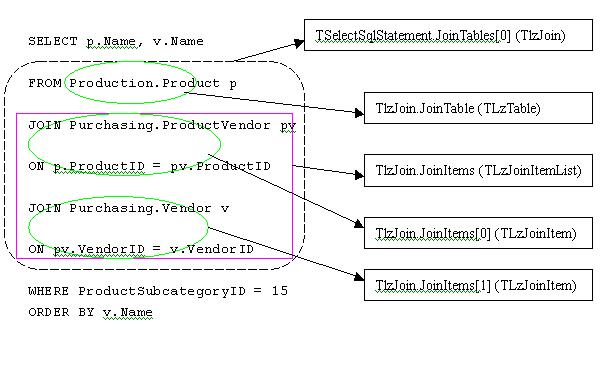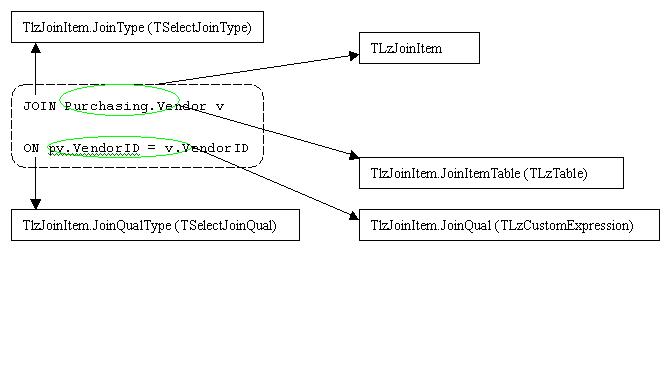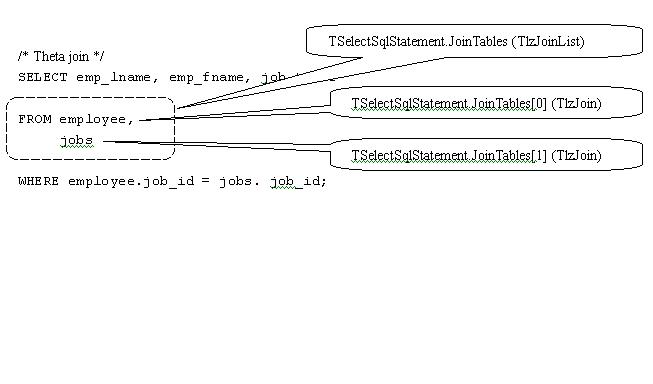From the following 3 diagrams, you may have a better understand of TLzJoin , TLzJoinList, TLzJoinItem, TLzJoinItemList which is used to represent join table in from clause.
You can check TSelectSqlStatement.JoinTables which is type of TLzJoinList to start fetching all those information.



Select t1.f1 from my.table1 t1,my.table2 t2 where t1.f1 = t2.f1
After parsing this sql, information in TSelectSqlStatement.Tables is:
Tables.Count = 2; Tables[0].TableName = 'table1'; Tables[0].TablePrefix = 'my'; Tables[0].TableAlias = 't1'; Tables[1].TableName = 'table2'; Tables[1].TablePrefix = 'my'; Tables[1].TableAlias = 't2'; And information in TSelectSqlStatement.JoinTables is: JoinTables.Count = 2; JoinTables.items[0].JoinTableType = jttTable; // the collection of join is table : my.table1 JoinTables.items[0].JoinTable = Tables[0];//my.table1 JoinTables.items[0].JoinItems.count = 0; JoinTables.items[1].JoinTableType = jttTable; // the collection of join is table : my.table1 JoinTables.items[1].JoinTable = Tables[1];//my.table2 JoinTables.items[1].JoinItems.count = 0;
Select t1.f1 from my.table1 t1 join my.table2 t2 on t1.f1 = t2.f1
After parsing this sql, information in TSelectSqlStatement.Tables is:
Tables.Count = 2; Tables[0].TableName = 'table1'; Tables[0].TablePrefix = 'my'; Tables[0].TableAlias = 't1'; Tables[1].TableName = 'table2'; Tables[1].TablePrefix = 'my'; Tables[1].TableAlias = 't2';
everything is the same as scenario 1, Now, check the information in JoinTables:
JoinTables.Count = 1; JoinTables.items[0].JoinTableType = jttTable; // the collection of join is table : my.table1 JoinTables.items[0].JoinTable = Tables[0];//my.table1 JoinTables.items[0].JoinItems.count = 1; JoinTables.items[0].JoinItems[0].JoinItemTableType = jttTable;//the collection of this joinitem is table:my.table2 JoinTables.items[0].JoinItems[0].JoinItemTable = my.table2; JoinTables.items[0].JoinItems[0].JoinType = sjtjoin; JoinTables.items[0].JoinItems[0].JoinQualType = sjqOn; JoinTables.items[0].JoinItems[0].JoinQual = AEXPRESSION ; //a custom expressoin point to t1.f1 = t2.f1
select t1.f1 from my.table1 t1 join (my.table2 t2 left join my.table3 t3 on t2.f1 = t3.f1) as joinalias1 on t1.f1 = t2.f1;
After parsing this sql, information in Tables is:
Tables.Count = 3; Tables[0].TableName = 'table1'; Tables[0].TablePrefix = 'my'; Tables[0].TableAlias = 't1'; Tables[1].TableName = 'table2'; Tables[1].TablePrefix = 'my'; Tables[1].TableAlias = 't2'; Tables[2].TableName = 'table3'; Tables[2].TablePrefix = 'my'; Tables[2].TableAlias = 't3';
Now, checking the information in JoinTables:
JoinTables.Count = 1; JoinTables.items[0].JoinTableType = jttTable; // the collection of join is table : my.table1 JoinTables.items[0].JoinTable = Tables[0];//my.table1 JoinTables.items[0].JoinItems.count = 1; JoinTables.items[0].JoinItems[0].JoinItemTableType = jttJoin;//the collection of this joinitem is join JoinTables.items[0].JoinItems[0].JoinItemJoin = AJoin; // ajoin point to (my.table2 t2 left join my.table3 t3 on t2.f1 = t3.f1) as joinalias1 JoinTables.items[0].JoinItems[0].JoinType = sjtjoin; JoinTables.items[0].JoinItems[0].JoinQualType = sjqOn; JoinTables.items[0].JoinItems[0].JoinQual = AEXPRESSION ; //a custom expressoin point to t1.f1 = t2.f1 JoinTables.items[0].JoinItems[0].JoinItemJoin.JoinTableType = jttTable; JoinTables.items[0].JoinItems[0].JoinItemJoin.JoinTable = Tables[1]; //my.table2 JoinTables.items[0].JoinItems[0].JoinItemJoin.Alias = joinalias1 JoinTables.items[0].JoinItems[0].JoinItemJoin.AliasWithAs = true; JoinTables.items[0].JoinItems[0].JoinItemJoin.NestedLevel = 1; JoinTables.items[0].JoinItems[0].JoinItemJoin.JoinItems.count = 1; JoinTables.items[0].JoinItems[0].JoinItemJoin.JoinItems[0].JoinItemTableType = jttTable; JoinTables.items[0].JoinItems[0].JoinItemJoin.JoinItems[0].JoinItemTable = Tables[2]; //my.table3 JoinTables.items[0].JoinItems[0].JoinItemJoin.JoinItems[0].JoinType = sjtleft; JoinTables.items[0].JoinItems[0].JoinItemJoin.JoinItems[0].JoinQualType = jqtOn; JoinTables.items[0].JoinItems[0].JoinItemJoin.JoinItems[0].JoinQual = AEXPRESSION ; //a custom expressoin point to t2.f1 = t3.f1
select t1.f1 from my.table1 t1 right join ((my.table2 t2 left outer join my.table3 t3 on (t2.f1 = t3.f2)) left join (my.table4 t4 full outer join my.table5 t5 on (t4.f1 = t5.f1)) t4alias on (t4.b1 = t2.c1)) on (t1.a1 = t3.b3);
After parsing this sql, information in Tables is:
Tables.Count = 5; Tables[0].TableName = 'table1'; Tables[0].TablePrefix = 'my'; Tables[0].TableAlias = 't1'; Tables[1].TableName = 'table2'; Tables[1].TablePrefix = 'my'; Tables[1].TableAlias = 't2'; Tables[2].TableName = 'table3'; Tables[2].TablePrefix = 'my'; Tables[2].TableAlias = 't3'; Tables[3].TableName = 'table4'; Tables[3].TablePrefix = 'my'; Tables[3].TableAlias = 't4'; Tables[4].TableName = 'table5'; Tables[4].TablePrefix = 'my'; Tables[4].TableAlias = 't5';
Now, checking the information in JoinTables:
JoinTables.Count = 1; JoinTables.items[0].JoinTableType = jttTable; JoinTables.items[0].JoinTable = Tables[0]; //my.table1 JoinTables.items[0].JoinItems.count = 1; JoinTables.items[0].JoinItems[0].JoinType = sjtrightjoin; JoinTables.items[0].JoinItems[0].JoinQualType = sjqOn; JoinTables.items[0].JoinItems[0].JoinQual = AEXPRESSION ; //a custom expressoin point to t1.a1 = t3.b3 JoinTables.items[0].JoinItems[0].JoinItemType = jttJoin; JoinTables.items[0].JoinItems[0].JoinItemJoin = AJoin; // ((my.table2 t2 left outer join my.table3 t3 on (t2.f1 = t3.f2)) left join (my.table4 t4 full outer join my.table5 t5 on (t4.f1 = t5.f1)) t4alias on (t4.b1 = t2.c1)) AJoin.NestedLevel = 1; AJoin.JoinTableType = jttJoin; AJoin.JoinJoin = ASubJoin; //(my.table2 t2 left outer join my.table3 t3 on (t2.f1 = t3.f2)) ASubJoin.NestedLevel = 1; ASubJoin.JoinTableType = jttTable; ASubJoin.JoinTable = Tables[1]; //my.table2 ASubJoin.JoinItems.count = 1; ASubJoin.JoinItems.items[0].JoinType = sjtleftjoin; ASubJoin.JoinItems.items[0].JoinQualType = jtqon; ASubJoin.JoinItems.items[0].JoinQual = AExpression;//t2.f1 = t3.f2 ASubJoin.JoinItems.items[0].JoinItemTableType = jttTable; ASubJoin.JoinItems.items[0].JoinItemTable = Tables[2]; //my.table3 AJoin.JoinItems.count = 1; AJoin.JoinItems.items[0].JoinTableType = jttJoin;//again, this is a join AJoin.JoinItems.items[0].JoinJoin = ASub2Join;//(my.table4 t4 full outer join my.table5 t5 on (t4.f1 = t5.f1)) t4alias ASub2Join.Alias = t4alias; ASub2Join.NestedLevel = 1; ASub2Join.JoinTableType = jttTable; ASub2Join.JoinTable = Tables[3]; //my.table4 ASub2Join.JoinItems.count = 1; ASub2Join.JoinItems.items[0].JoinType = sjtfullOuter; ASub2Join.JoinItems.items[0].JoinQualType = jtqon; ASub2Join.JoinItems.items[0].JoinQual = AExpression;//t4.f1 = t5.f1 ASub2Join.JoinItems.items[0].JoinItemTableType = jttTable; ASubJoin.JoinItems.items[0].JoinItemTable = Tables[4]; //my.table5 AJoin.JoinItems.items[0].JoinType = sjtleftouter;//left join AJoin.JoinItems.items[0].JoinQualType = sjqOn; AJoin.JoinItems.items[0].JoinQual = sjqOn;// t4.b1 = t2.c1
You may also check this demo: